Pre- and Post-Endurance Training Mitigates the Rat Pilocarpine-Induced Status Epilepticus and Epileptogenesis-Associated Deleterious Consequences
Abstract
1. Introduction
2. Results
2.1. The Endurance Training, Applied before and after SE, Mitigated the Pilocarpine-Induced Status Epilepticus in the Rat
2.2. The Endurance Training, Applied before and after SE, Alleviated SMS in the Pilo-Induced Post-SE Rat Model of TLE
2.3. Behavioral Tests
2.3.1. The Endurance Training, Applied before and after SE, Improved the Formation of Short- and Long-Term Memory Traces in the Step-Down Test in the Pilo-Induced Post-SE Rat Model of TLE
2.3.2. The Endurance Training, Applied before and after SE, Corrected the Impairment of Associative Memory in the Object Recognition Test in the Pilo-Induced Post-SE Rat Model of TLE
2.3.3. The Endurance Training, Applied before and after SE, Improved Spatial Memory in the Eight-Radial Arm Maze Test in the Pilo-Induced Post-SE Rat Model of TLE
2.3.4. The Endurance Training, Applied before and after SE, Failed to Correct the Pilocarpine-Induced Impairment on Anxiety Response in the Open Field Test in the Pilo-Induced Post-SE Rat Model of TLE
2.3.5. Endurance Training, Applied before and after SE, Alleviated the Anxiety-Like Behavior in the Elevated Plus Maze Test (EPM) in the Pilo-Induced Post-SE Rat Model of TLE
2.3.6. Endurance Training, Applied before and after SE, Alleviated the Depressive-Like Behavior in the Pilo-Induced Post-SE Rat Model of TLE
2.4. Endurance Training, Applied before and after SE, Mitigated the Oxidative Stress in the Hippocampus in the Pilo-Induced Post-SE Rat Model of TLE
2.5. Endurance Training, Applied before and after SE, Reduced the Pro-Inflammatory Cytokines Interleukin (IL)-1β Levels and Tumor Necrosis Factor (TNF)-α in the Hippocampus in the Pilo-Induced Post-SE Rat Model of TLE
3. Discussion
4. Materials and MethodsV
4.1. Reagents
4.2. Animals
4.3. Study Timeline, Aerobic Training Protocol, and Induction of SE
4.3.1. Aerobic Training Protocol
4.3.2. Induction of SE with Pilocarpine
4.4. Video Monitoring of Spontaneous Motor Seizures (SMS)
4.5. Behavioural Tests
4.5.1. Step-Down Test
4.5.2. Object Recognition Test
4.5.3. Sucrose Preference Test
4.5.4. Eight-Radial Arm Maze Test
4.5.5. Open Field Test
4.5.6. Elevated Plus Maze Test
4.6. Markers of Oxidative Stress in the Hippocampus
4.6.1. Preparation of Tissue Homogenate
4.6.2. Protein Content
4.6.3. MDA Assay
4.6.4. SOD Activity Assay
4.6.5. CAT Activity Assay
4.6.6. GSH Assay
4.7. Measurement of IL-1β and TNF-α in the Hippocampus
4.8. Statistical Analysis
5. Conclusions
Author Contributions
Funding
Institutional Review Board Statement
Informed Consent Statement
Data Availability Statement
Conflicts of Interest
Abbreviations
| ANOVA | analysis of variance |
| CAT | catalase |
| DTNB | 5,5′-dithio-bis-(2-nitrobenzoic acid |
| EPM | elevated plus maze |
| Ex | exercised |
| GSH | reduced glutathione |
| IL-1β | interleukin-1β |
| IL-6 | interleukin-6 |
| MDA | malondialdehyde |
| NBT | nitroblue tetrazolium |
| OP | open field |
| ORT | object recognition test |
| Pilo | pilocarpine |
| PMS | phenazine methosulfate |
| RAM | eight-radial arm maze |
| SE | status epilepticus |
| Sed | sedentary |
| SOD | superoxide dismutase |
| SMS | spontaneous motor seizures |
| TBA | thiobarbituric acid |
| TCA | trichloroacetic acid |
| TNF-α | tumor necrosis factor-α |
| WME | working memory errors |
References
- Dechandt, C.R.P.; Vicentini, T.M.; Lanfredi, G.P.; Silva-Jr, R.M.P.; Espreafico, E.M.; de Oliveira, J.A.C.; Faça, V.M.; Garcia-Cairasco, N.; Alberici, L.C. The highly efficient powerhouse in the Wistar audiogenic rat, an epileptic rat strain. Am. J. Physiol. Regul. Integr. Comp. Physiol. 2019, 316, R243–R254. [Google Scholar] [CrossRef] [PubMed]
- Vannucci, C.D.; Lopim, G.M.; da Silva, D.A.; de Almeida, A.A.; Amado, D.; Arida, R.M. Epilepsy and exercise: An experimental study in female rats. Physiol. Behav. 2017, 171, 120–126. [Google Scholar] [CrossRef] [PubMed]
- Fisher, R.S.; van Emde, B.W.; Blume, W.; Elger, C.; Genton, P.; Lee, P.; Engel, J., Jr. Epileptic seizures and epilepsy: Definitions proposed by the International League Against Epilepsy (ILAE) and the International Bureau for Epilepsy (IBE). Epilepsia 2005, 46, 470–472. [Google Scholar] [CrossRef] [PubMed]
- Chen, B.; Choi, H.; Hirsch, L.J.; Katz, A.; Legge, A.; Buchsbaum, R.; Detyniecki, K. Psychiatric and behavioral side effects of antiepileptic drugs in adults with epilepsy. Epilepsy Behav. 2017, 76, 24–31. [Google Scholar] [CrossRef]
- Cavalcante, B.R.R.; Improta-Caria, A.C.; Melo, V.H.; De Sousa, R.A.L. Exercise-linked consequences on epilepsy. Epilepsy Behav. 2021, 121, 108079. [Google Scholar] [CrossRef]
- Nakken, K.O.; Løyning, A.; Løyning, T.; Gløersen, G.; Larsson, P.G. Does physical exercise influence the occurrence of epileptiform EEG discharges in children? Epilepsia 1997, 38, 279–284. [Google Scholar] [CrossRef]
- Arida, R.M.; de Jesus, V.A.; Cavalheiro, E.A. Effect of physical exercise on kindling development. Epilepsy Res. 1998, 30, 127–132. [Google Scholar] [CrossRef]
- de Lima, C.; Vancini, R.L.; Arida, R.M.; Guilhoto, L.M.; de Mello, M.T.; Barreto, A.T.; Guaranha, M.S.; Yacubian, E.M.; Tufik, S. Physiological and electroencephalographic responses to acute exhaustive physical exercise in people with juvenile myoclonic epilepsy. Epilepsy Behav. 2011, 22, 718–722. [Google Scholar] [CrossRef]
- Capovilla, G.; Kaufman, K.R.; Perucca, E.; Moshé, S.L.; Arida, R.M. Epilepsy, seizures, physical exercise, and sports: A report from the ILAE Task Force on Sports and Epilepsy. Epilepsia 2016, 57, 6–12. [Google Scholar] [CrossRef]
- Kemi, O.J.; Wisloff, U. High-intensity aerobic exercise training improves the heart in health and disease. J. Cardiopulm. Rehabil. Prev. 2010, 30, 2–11. [Google Scholar] [CrossRef]
- Arida, R.M.; de Almeida, A.C.; Cavalheiro, E.A.; Scorza, F.A. Experimental and clinical findings from physical exercise as complementary therapy for epilepsy. Epilepsy Behav. 2013, 26, 273–278. [Google Scholar] [CrossRef] [PubMed]
- Swift, D.L.; McGee, J.E.; Earnest, C.P.; Carlisle, E.; Nygard, M.; Johannsen, N.M. The Effects of Exercise and Physical Activity on Weight Loss and Maintenance. Prog. Cardiovasc. Dis. 2018, 61, 206–213. [Google Scholar] [CrossRef] [PubMed]
- Shishmanova-Doseva, M.; Peychev, L.; Koeva, Y.; Terzieva, D.; Georgieva, K.; Peychev, Z. Chronic treatment with the new anticonvulsant drug lacosamide impairs learning and memory processes in rats: A possible role of BDNF/TrkB ligand receptor system. Pharmacol. Biochem. Behav. 2018, 169, 1–9. [Google Scholar] [CrossRef] [PubMed]
- Thapar, A.; Kerr, M.; Harold, G. Stress, anxiety, depression, and epilepsy: Investigating the relationship between psychological factors and seizures. Epilepsy Behav. 2009, 14, 134–140. [Google Scholar] [CrossRef]
- Scorza, F.A.; Arida, R.M.; Naffah-Mazzacoratti, M.G.; Scerni, D.A.; Calderazzo, L.; Cavalheiro, E.A. The pilocarpine model of epilepsy: What have we learned? Acad Bras. Cienc. 2009, 81, 345–365. [Google Scholar] [CrossRef]
- Sharma, A.K.; Reams, R.Y.; Jordan, W.H.; Miller, M.A.; Thacker, H.L.; Snyder, P.W. Mesial temporal lobe epilepsy: Pathogenesis, induced rodent models and lesions. Toxicol. Pathol. 2007, 35, 984–999. [Google Scholar] [CrossRef] [PubMed]
- Chaouloff, F. Physical exercise and brain monoamines: A review. Acta Physiol. Scand. 1989, 137, 1–13. [Google Scholar] [CrossRef]
- Dunn, A.L.; Reigle, T.G.; Youngstedt, S.D.; Armstrong, R.B.; Dishman, R.K. Brain norepinephrine and metabolites after treadmill training and wheel running in rats. Med. Sci. Sports Exerc. 1996, 28, 204–209. [Google Scholar] [CrossRef]
- Holmes, P.V.; Reiss, J.I.; Murray, P.S.; Dishman, R.K.; Jessica, M.; Spradley, J.M. Chronic exercise dampens hippocampal glutamate overflow induced by kainic acid in rats. Behav. Brain Res. 2015, 284, 19–23. [Google Scholar] [CrossRef]
- Hui, Y.Y.; Ahmad, N.; Makmor-Bakry, M. Pathogenesis of epilepsy: Challenges in animal models. Iran J. Basic Med. Sci. 2013, 16, 1119–1132. [Google Scholar]
- Lee, S.J. Effects of preconditioning exercise on nitric oxide and antioxidants in hippocampus of epileptic seizure. J. Exerc. Rehabil. 2019, 15, 757–762. [Google Scholar] [CrossRef] [PubMed]
- Arida, R.M.; Scorza, F.A.; dos Santos, N.F.; Peres, C.A.; Cavalheiro, E.A. Effect of physical exercise on seizure occurrence in a model of temporal lobe epilepsy in rats. Epilepsy Res. 1999, 37, 45–52. [Google Scholar] [CrossRef]
- Setkowicz, Z.; Mazur, A. Physical training decreases susceptibility to subsequent pilocarpine-induced seizures in the rat. Epilepsy Res. 2006, 71, 142–148. [Google Scholar] [CrossRef]
- Sumien, N. Interactions of antioxidant supplementation and moderate exercise on brain function. Exp. Gerontol. 2017, 94, 122–123. [Google Scholar] [CrossRef]
- de Almeida, A.A.; da Silva, G.S.; Lopim, G.M.; Vannucci, C.D.; Fernandes, J.; Cabral, F.R.; Arida, R.M. Resistance Exercise Reduces Seizure Occurrence, Attenuates Memory Deficits and Restores BDNF Signaling in Rats with Chronic Epilepsy. Neurochem. Res. 2017, 42, 1230–1239. [Google Scholar] [CrossRef] [PubMed]
- Lee, J.M.; Ji, E.S.; Kim, T.W.; Kim, C.J.; Shin, M.S.; Lim, B.V.; Chung, Y.R.; Cho, Y.S. Treadmill exercise improves memory function by inhibiting hippocampal apoptosis in pilocarpine-induced epileptic rats. J. Exerc. Rehabil. 2018, 14, 713–723. [Google Scholar] [CrossRef] [PubMed]
- Lin, X.Y.; Cui, Y.; Wang, L.; Chen, W. Chronic exercise buffers the cognitive dysfunction and decreases the susceptibility to seizures in PTZ-treated rats. Epilepsy Behav. 2019, 98, 173–187. [Google Scholar] [CrossRef]
- Weatherburn, C.J.; Heath, C.A.; Mercer, S.W.; Guthrie, B. Physical and mental health comorbidities of epilepsy: Population-based cross-sectional analysis of 1.5 million people in Scotland. Seizure 2017, 45, 125–131. [Google Scholar] [CrossRef]
- Vollert, C.; Zagaar, M.; Hovatta, I.; Taneja, M.; Vu, A.; Dao, A.; Levine, A.; Alkadhi, K.; Salim, S. Exercise prevents sleep deprivation-associated anxiety-like behavior in rats: Potential role of oxidative stress mechanisms. Behav. Brain Res. 2011, 224, 233–240. [Google Scholar] [CrossRef]
- Patki, G.; Solanki, N.; Atrooz, F.; Ansari, A.; Allam, F.; Jannise, B.; Maturi, J.; Salim, S. Novel mechanistic insights into treadmill exercise based rescue of social defeat-induced anxiety-like behavior and memory impairment in rats. Physiol. Behav. 2014, 130, 135–144. [Google Scholar] [CrossRef]
- Stanton, R.; Reaburn, P. Exercise and the treatment of depression: A review of the exercise program variables. J. Sci. Med. Sport. 2014, 17, 177–182. [Google Scholar] [CrossRef] [PubMed]
- Kochi, C.; Liu, H.; Zaidi, S.; Atrooz, F.; Dantoin, P.; Salim, S. Prior treadmill exercise promotes resilience to vicarious trauma in rats. Prog. Neuropsychopharmacol. Biol. Psychiatry 2017, 77, 216–221. [Google Scholar] [CrossRef] [PubMed]
- Tchekalarova, J.; Shishmanova, M.; Atanasova, D.; Stefanova, M.; Alova, L.; Lazarov, N.; Georgieva, K. Effect of endurance training on seizure susceptibility, behavioral changes and neuronal damage after kainate-induced status epilepticus in spontaneously hypertensive rats. Brain Res. 2015, 1625, 39–53. [Google Scholar] [CrossRef] [PubMed]
- Epps, S.A.; Kahn, A.B.; Holmes, P.V.; Boss-Williams, K.A.; Weiss, J.M.; Weinshenker, D. Antidepressant and anticonvulsant effects of exercise in a rat model of epilepsy and depression comorbidity. Epilepsy Behav. 2013, 29, 47–52. [Google Scholar] [CrossRef] [PubMed][Green Version]
- Goldfarb, A.H.; Jamurtas, A.Z. Beta-endorphin response to exercise. Sports Med. 1997, 24, 8–16. [Google Scholar] [CrossRef]
- Zouhal, H.; Jacob, C.; Delamarche, P.; Gratas-Delamarche, A. Catecholamines and the effects of exercise, training and gender. Sports Med. 2008, 38, 401–423. [Google Scholar] [CrossRef]
- Klempin, F.; Beis, D.; Mosienko, V.; Kempermann, G.; Bader, M.; Alenina, N. Serotonin is required for exercise-induced adult hippocampal neurogenesis. J. Neurosci. 2013, 33, 8270–8275. [Google Scholar] [CrossRef]
- Jobe, P.C.; Dailey, J.W.; Wernicke, J.F. A noradrenergic and serotonergic hypothesis of the linkage between epilepsy and affective disorders. Crit. Rev. Neurobiol. 1999, 13, 317–356. [Google Scholar] [CrossRef]
- Peng, W.F.; Fan, F.; Li, X.; Zhang, Q.Q.; Ding, J.; Wang, X. Different behavioral and pathological changes between epilepsy-associated depression and primary depression models. Epilepsy Behav. 2018, 83, 212–218. [Google Scholar] [CrossRef]
- Kim, H.J.; Kim, I.; KSong, W.; Lee, J.; Park, S. The synergic effect of regular exercise and resveratrol on kainate-induced oxidative stress and seizure activity in mice. Neurochem. Res. 2013, 38, 117–122. [Google Scholar] [CrossRef]
- Folbergrová, J.; Ješina, P.; Kubová, H.; Otáhal, J. Effect of Resveratrol on Oxidative Stress and Mitochondrial Dysfunction in Immature Brain during Epileptogenesis. Mol. Neurobiol. 2018, 55, 7512–7522. [Google Scholar] [CrossRef] [PubMed]
- Ali, A.E.; Mahdy, H.M.; Elsherbiny, D.M.; Azab, S.S. Rifampicin ameliorates lithium-pilocarpine-induced seizures, consequent hippocampal damage and memory deficit in rats: Impact on oxidative, inflammatory and apoptotic machineries. Biochem. Pharmacol. 2018, 156, 431–443. [Google Scholar] [CrossRef] [PubMed]
- Kayacan, Y.; Yazar, H.; Kisa, E.C.; Ghojebeigloo, B.E. A novel biomarker explaining the role of oxidative stress in exercise and l-tyrosine supplementation: Thiol/disulphide homeostasis. Arch. Physiol. Biochem. 2018, 124, 232–236. [Google Scholar] [CrossRef] [PubMed]
- Kitov, B.; Epifanceva, E.; Asenova, R.; Kitova, T. Stress and its importance for the human body. Gen. Med. 2020, XXII, 74–81. [Google Scholar]
- Waldbaum, S.; Patel, M. Mitochondria, oxidative stress, and temporal lobe epilepsy. Epilepsy Res. 2010, 88, 23–45. [Google Scholar] [CrossRef] [PubMed]
- Folbergrová, J. Oxidative stress in immature brain following experimentally-induced seizures. Physiol. Res. 2013, 62 (Suppl. 1), S39–S48. [Google Scholar] [CrossRef] [PubMed]
- Pearson, J.N.; Rowley, S.; Liang, L.P.; White, A.M.; Day, B.J.; Patel, M. Reactive oxygen species mediate cognitive deficits in experimental temporal lobe epilepsy. Neurobiol. Dis. 2015, 82, 289–297. [Google Scholar] [CrossRef]
- Vezzani, A.; Aronica, E.; Mazarati, A.; Pittman, Q.J. Epilepsy and brain inflammation. Exp. Neurol. 2013, 244, 11–21. [Google Scholar] [CrossRef]
- Shapiro, L.A.; Wang, L.; Ribak, C.E. Rapid astrocyte and microglial activation following pilocarpine-induced seizures in rats. Epilepsia 2008, 49 (Suppl. 2), 33–41. [Google Scholar] [CrossRef]
- Wang, X.; Yang, X.L.; Kong, W.L.; Zeng, M.L.; Shao, L.; Jiang, G.T.; Cheng, J.J.; Kong, S.; He, X.H.; Liu, W.H.; et al. TRPV1 translocated to astrocytic membrane to promote migration and inflammatory infiltration thus promotes epilepsy after hypoxic ischemia in immature brain. J. Neuroinflamm. 2019, 16, 214. [Google Scholar] [CrossRef]
- Devinsky, O.; Vezzani, A.; Najjar, S.; De Lanerolle, N.C.; Rogawski, M.A. Glia and epilepsy: Excitability and inflammation. Trends Neurosci. 2013, 36, 174–184. [Google Scholar] [CrossRef] [PubMed]
- Wang, Y.; Xu, Y.; Sheng, H.; Ni, X.; Lu, J. Exercise amelioration of depression-like behavior in OVX mice is associated with suppression of NLRP3 inflammasome activation in hippocampus. Behav. Brain Res. 2016, 307, 18–24. [Google Scholar] [CrossRef] [PubMed]
- Real, C.C.; Garcia, P.C.; Britto, L.R.G. Treadmill Exercise Prevents Increase of Neuroinflammation Markers Involved in the Dopaminergic Damage of the 6-OHDA Parkinson’s Disease Model. J. Mol. Neurosci. 2017, 63, 36–49. [Google Scholar] [CrossRef] [PubMed]
- Real, C.C.; Doorduin, J.; Kopschina Feltes, P.; Vállez García, D.; de Paula Faria, D.; Britto, L.R.; de Vries, E.F. Evaluation of exercise-induced modulation of glial activation and dopaminergic damage in a rat model of Parkinson’s disease using [11C]PBR28 and [18F]FDOPA PET. J. Cereb. Blood Flow Metab. 2019, 39, 989–1004. [Google Scholar] [CrossRef] [PubMed]
- Zhang, X.; He, Q.; Huang, T.; Zhao, N.; Liang, F.; Xu, B.; Chen, X.; Li, T.; Bi, J. Treadmill Exercise Decreases Aβ Deposition and Counteracts Cognitive Decline in APP/PS1 Mice, Possibly via Hippocampal Microglia Modifications. Front. Aging Neurosci. 2019, 11, 78. [Google Scholar] [CrossRef]
- Li, B.; Mao, Q.; Zhao, N.; Xia, J.; Zhao, Y.; Xu, B. Treadmill exercise overcomes memory deficits related to synaptic plasticity through modulating ionic glutamate receptors. Behav. Brain Res. 2021, 414, 113502. [Google Scholar] [CrossRef]
- Georgieva, K.; Boyadjiev, N. Effects of nandrolone decanoate on VO2max, running economy, and endurance in rats. Med. Sci. Sports Exerc. 2004, 36, 1336–1341. [Google Scholar] [CrossRef]
- Shishmanova-Doseva, M.; Georgieva, K.; Koeva, Y.; Terzieva, D.; Peychev, L. Enhancing effect of aerobic training on learning and memory performance in rats after long-term treatment with Lacosamide via BDNF-TrkB signaling pathway. Behav. Brain Res. 2019, 370, 111963. [Google Scholar] [CrossRef]
- Soya, H.; Nakamura, T.; Deocaris, C.C.; Kimpara, A.; Iimura, M.; Fujikawa, T.; Chang, H.; McEwen, B.S.; Nishijima, T. BDNF induction with mild exercise in the rat hippocampus. Biochem. Biophys. Res. Commun. 2007, 359, 961–967. [Google Scholar] [CrossRef]
- Radahmadi, M.; Alaei, H.; Sharifi, M.-R.; Hosseini, N. The effect of synchronized forced running with chronic stress on short, mid and long-term memory in rats. Asian J. Sports Med. 2013, 4, 54–62. [Google Scholar] [CrossRef]
- Racine, R.J. Modification of seizure activity by electrical stimulation. II. Motor seizure. Electroencephalogr. Clin. Neurophysiol. 1972, 32, 281–294. [Google Scholar] [CrossRef]
- Shishmanova-Doseva, M.; Peychev, L.; Yoanidu, L.; Uzunova, Y.; Atanasova, M.; Georgieva, K.; Tchekalarova, J. Anticonvulsant Effects of Topiramate and Lacosamide on Pilocarpine-Induced Status Epilepticus in Rats: A Role of Reactive Oxygen Species and Inflammation. Int. J. Mol. Sci. 2021, 22, 2264. [Google Scholar] [CrossRef]
- Shishmanova-Doseva, M.; Atanasova, D.; Uzunova, Y.; Yoanidu, L.; Peychev, L.; Marinov, P.; Tchekalarova, J. Effects of Lacosamide Treatment on Epileptogenesis, Neuronal Damage and Behavioral Comorbidities in a Rat Model of Temporal Lobe Epilepsy. Int. J. Mol. Sci. 2021, 22, 4667. [Google Scholar] [CrossRef] [PubMed]
- Shishmanova-Doseva, M.; Tchekalarova, J.; Nenchovska, Z.; Ivanova, N.; Georgieva, K.; Peychev, L. The Effect of Chronic Treatment with Lacosamide and Topiramate on Cognitive Functions and Impaired Emotional Responses in a Pilocarpine-induced Post-status Epilepticus Rat Model. Folia Med. 2020, 62, 723–729. [Google Scholar] [CrossRef] [PubMed]
- Shishmanova-Doseva, M.; Atanasova, D.; Ioanidu, L.; Uzunova, Y.; Atanasova, M.; Peychev, L.; Tchekalarova, J. The anticonvulsant effect of chronic treatment with topiramate after pilocarpine-induced status epilepticus is accompanied by a suppression of comorbid behavioral impairments and robust neuroprotection in limbic regions in rats. Epilepsy Behav. 2022, 134, 108802. [Google Scholar] [CrossRef] [PubMed]
- Atanasova, D.; Tchekalarova, J.; Ivanova, N.; Nenchovska, Z.; Pavlova, E.; Atanassova, N.; Lazarov, N. Losartan suppresses the kainate-induced changes of angiotensin AT1 receptor expression in a model of comorbid hypertension and epilepsy. Life Sci. 2018, 193, 40–46. [Google Scholar] [CrossRef]
- Tchekalarova, J.; Atanasova, D.; Kortenska, L.; Atanasova, M.; Lazarov, N. Chronic Agomelatine Treatment Prevents Comorbid Depression in the Post-Status Epilepticus Model of Acquired Epilepsy Through Suppression of Inflammatory Signaling. Neurobiol. Dis. 2018, 115, 127–144. [Google Scholar] [CrossRef]
- Tchekalarova, J.; Petkova, Z.; Pechlivanova, D.; Moyanova, S.; Kortenska, L.; Mitreva, R.; Lozanov, V.; Atanasova, D.; Lazarov, N.; Stoynev, A. Prophylactic treatment with melatonin after status epilepticus: Effects on epileptogenesis, neuronal damage and behavioral changes in kainate model of temporal lobe epilepsy. Epil. Behav. 2013, 21, 174–187. [Google Scholar] [CrossRef]
- Kakkar, P.; Das, B.; Viswanathan, P.N. A modified spectrophotometric assay of superoxide dismutase. Indian J. Biochem. Biophys. 1984, 21, 130–132. [Google Scholar]
- Bradford, M.M. A rapid and sensitive method for the quantitation of microgram quantities of protein utilizing the principle of protein-dye binding. Anal. Biochem. 1976, 72, 248–254. [Google Scholar] [CrossRef]

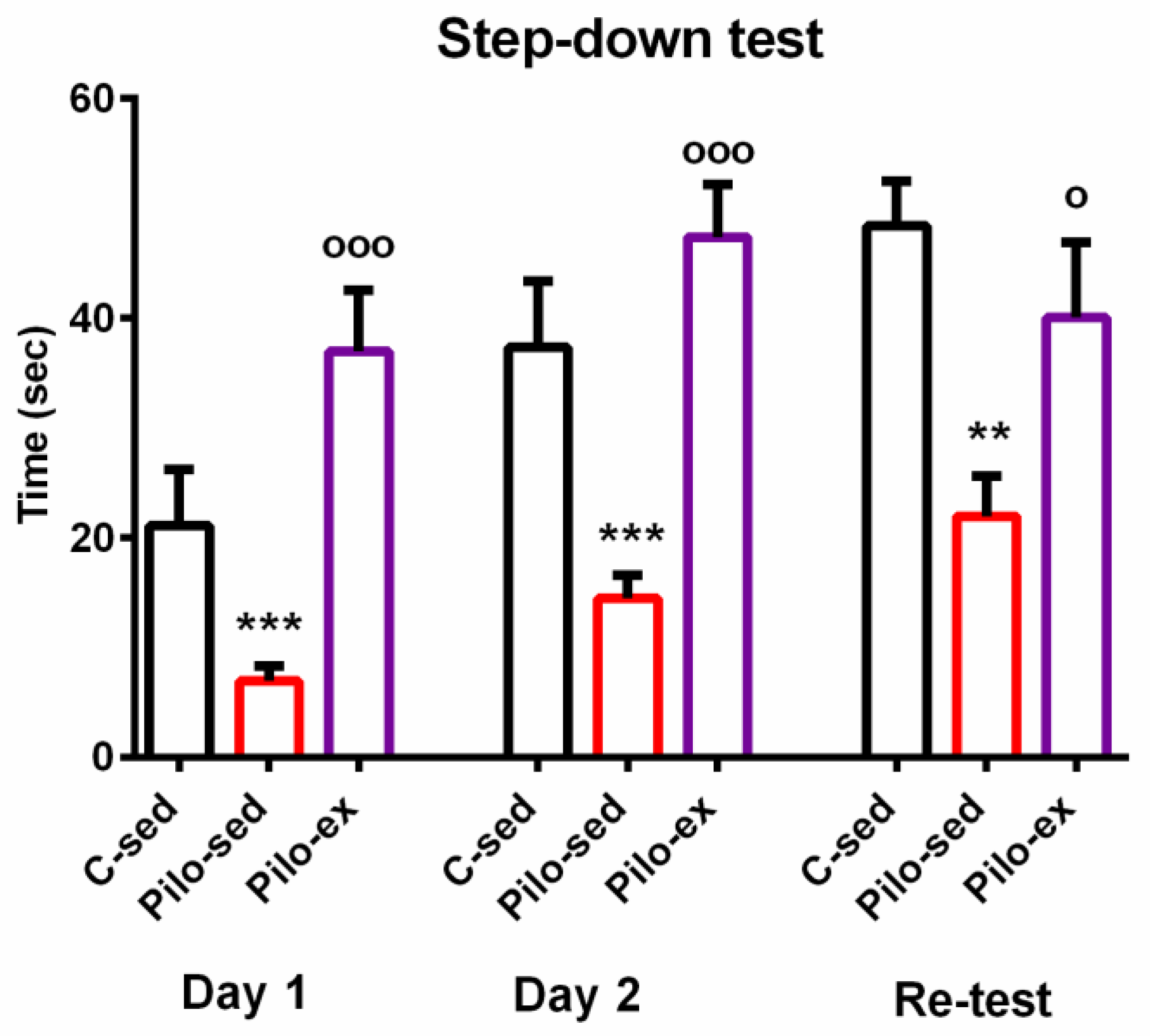
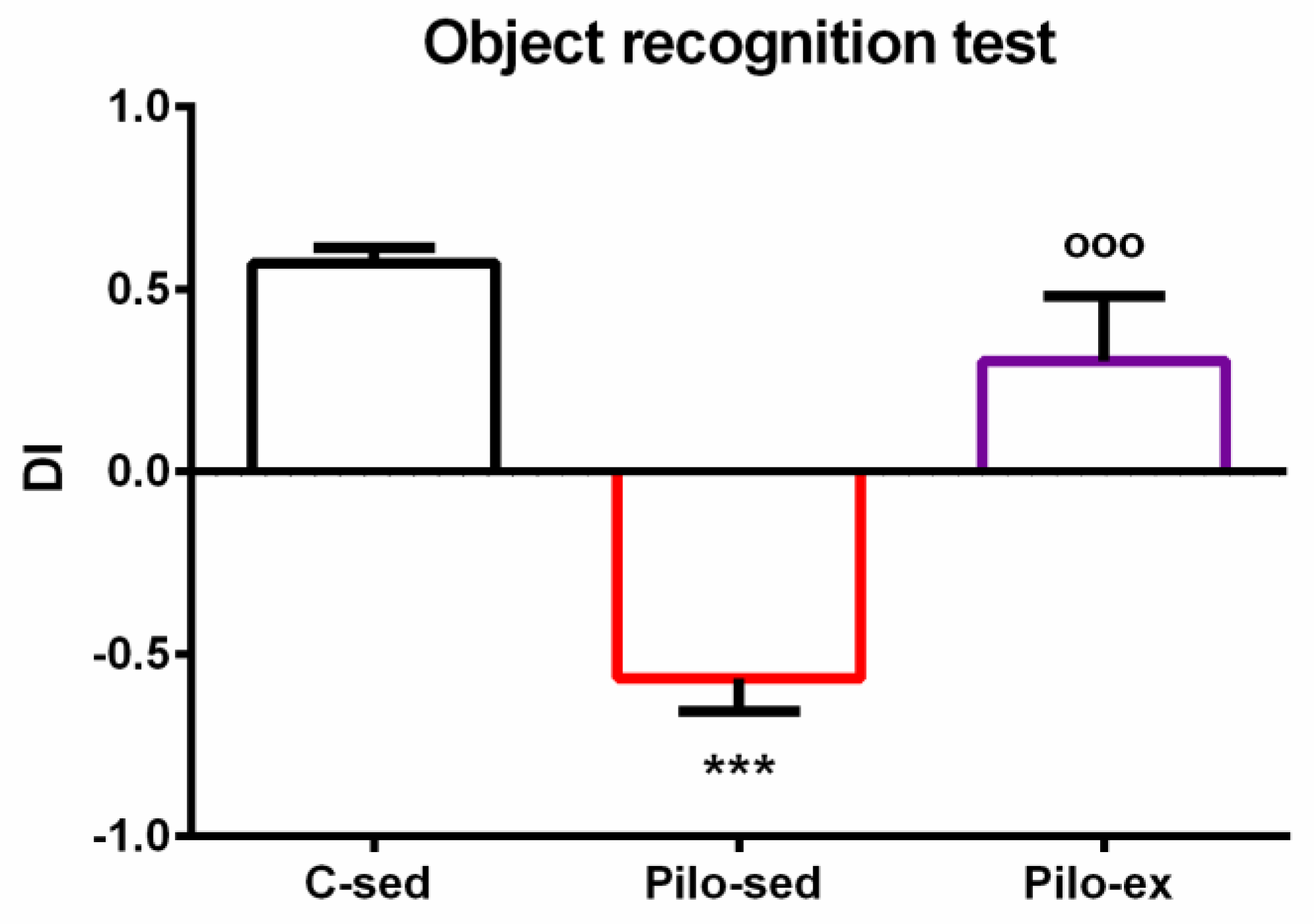
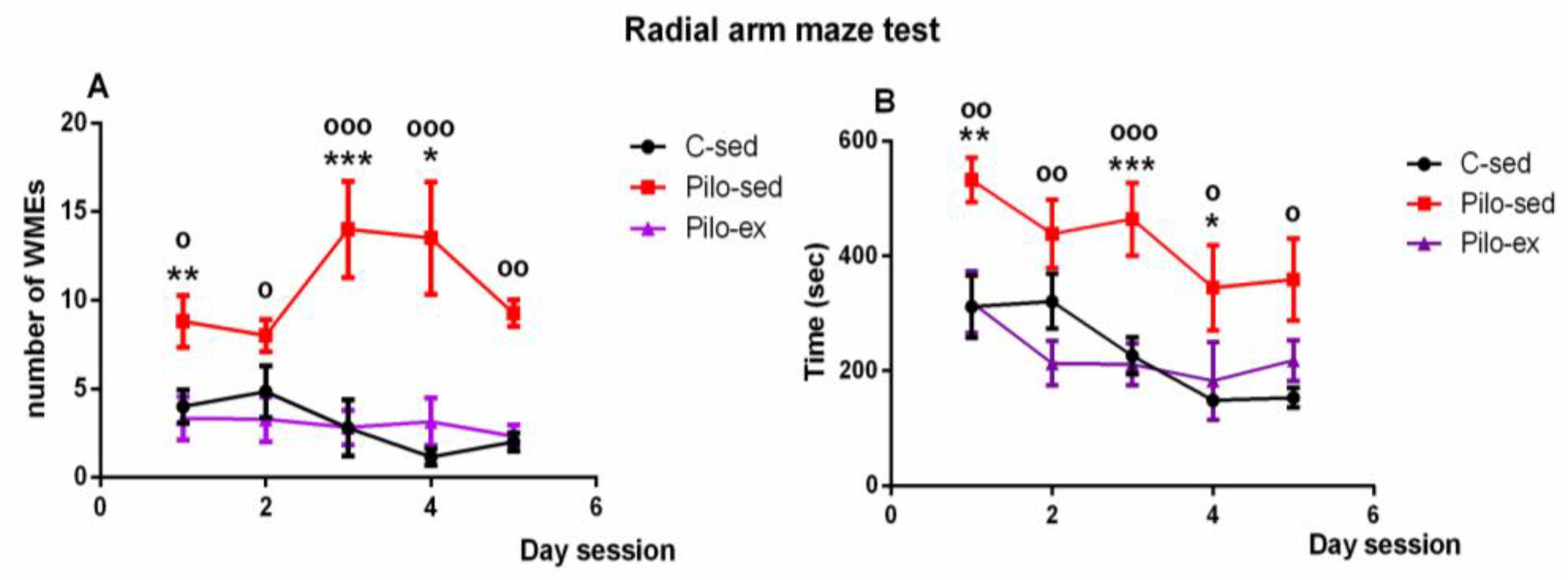
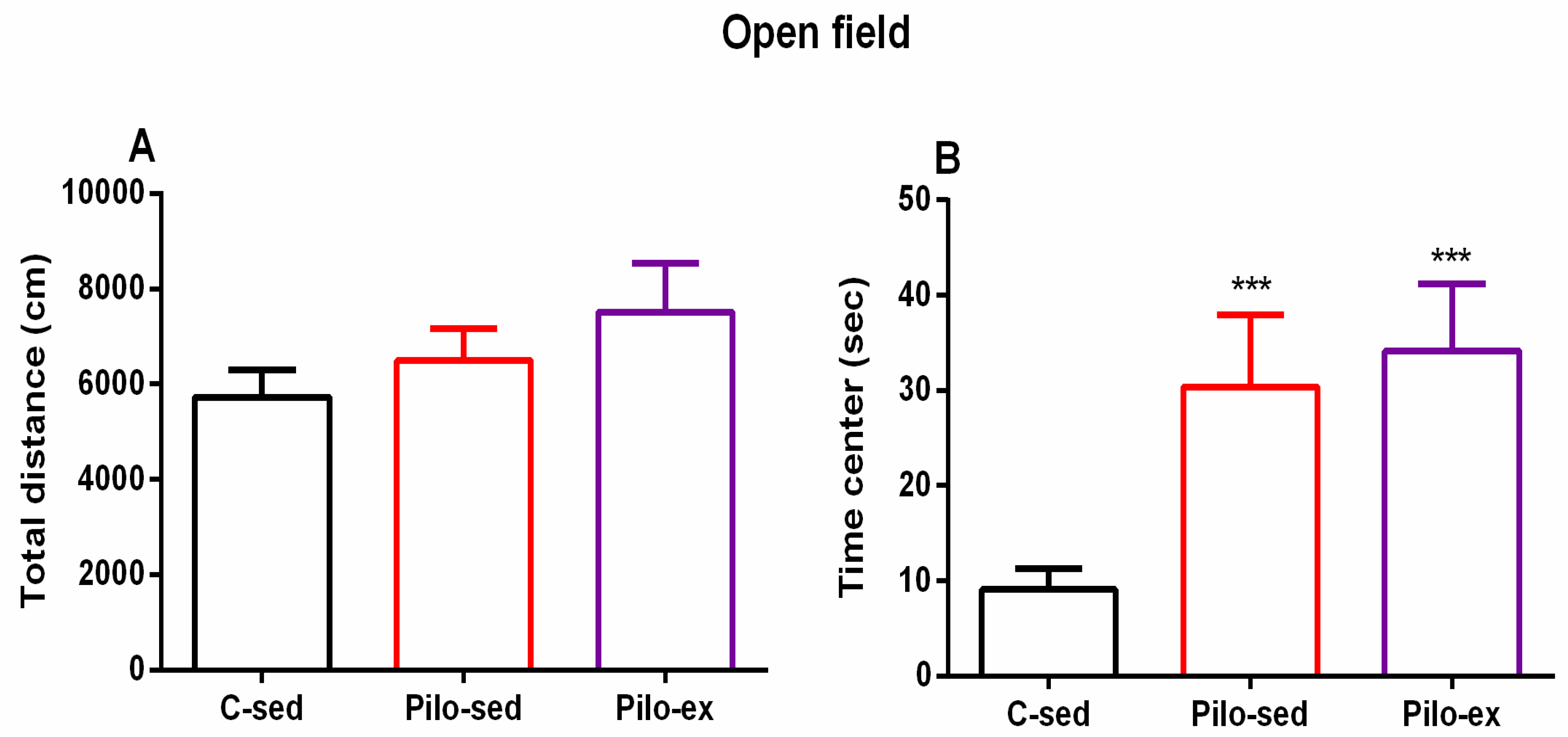
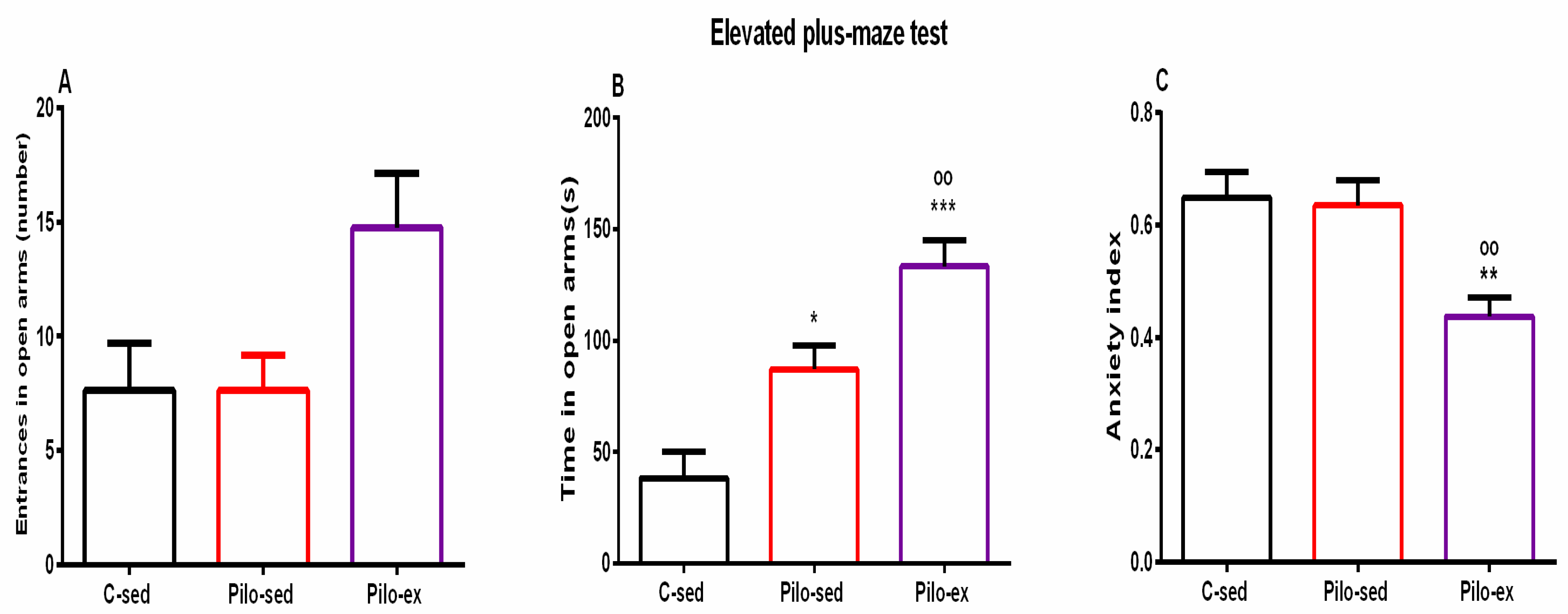
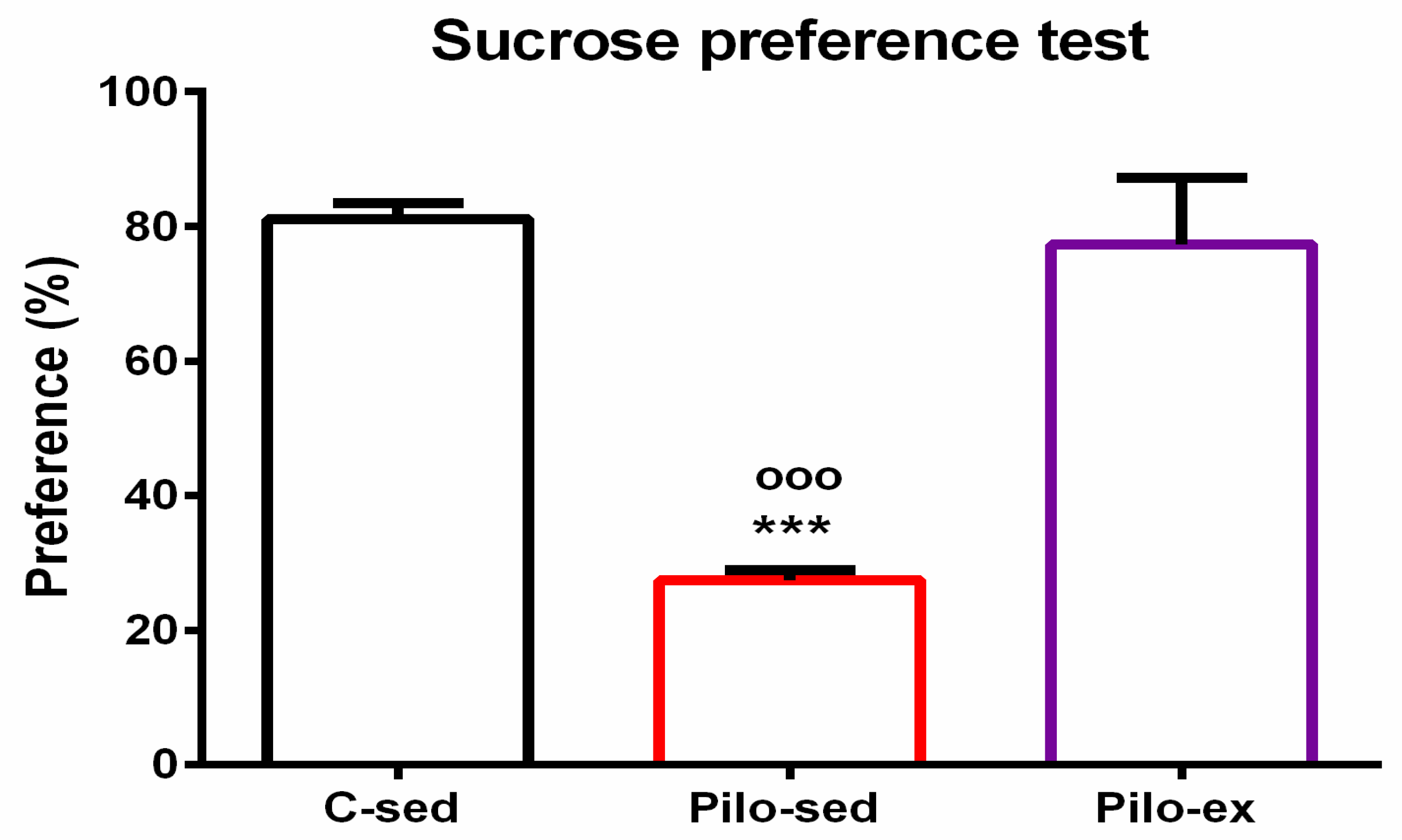
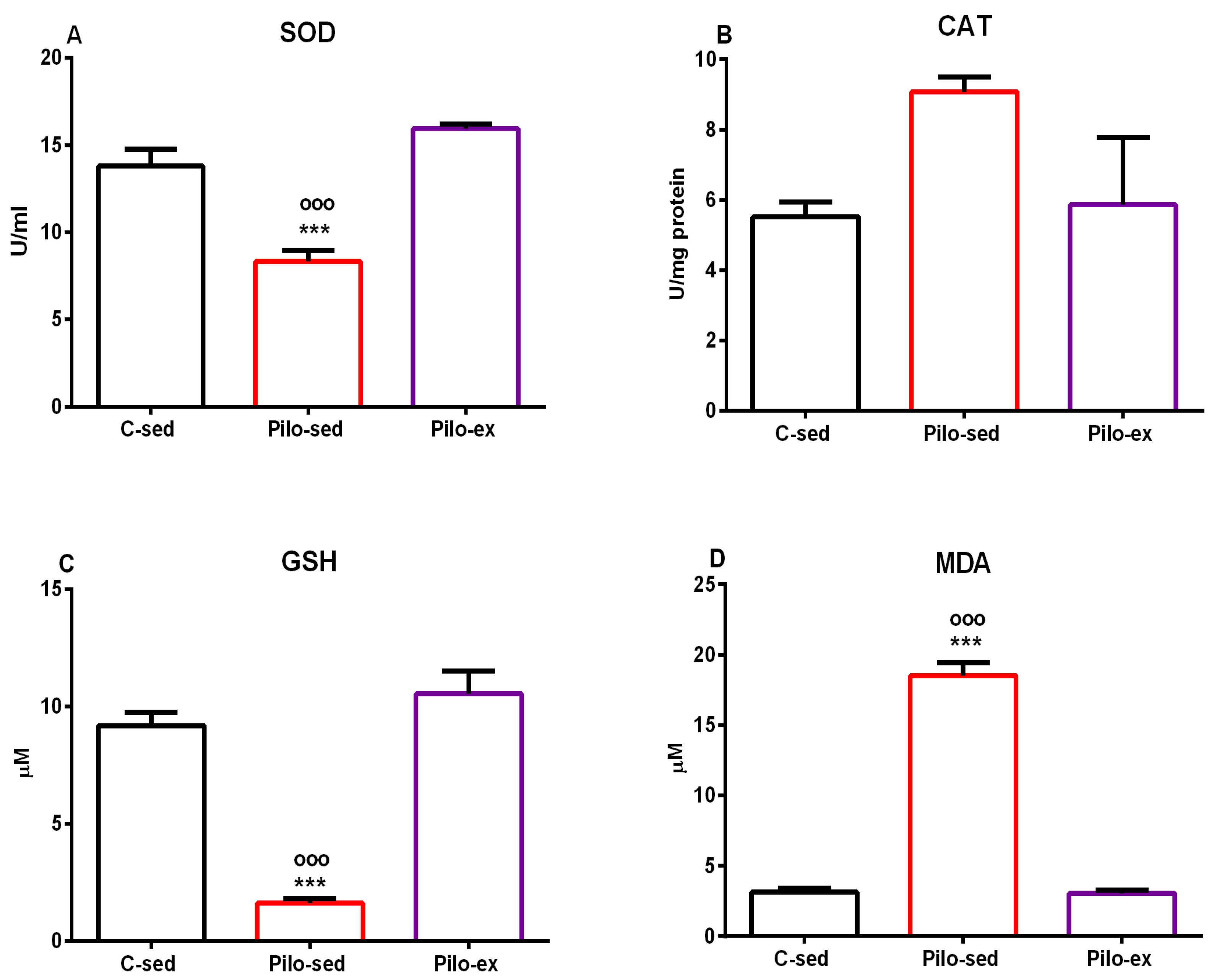
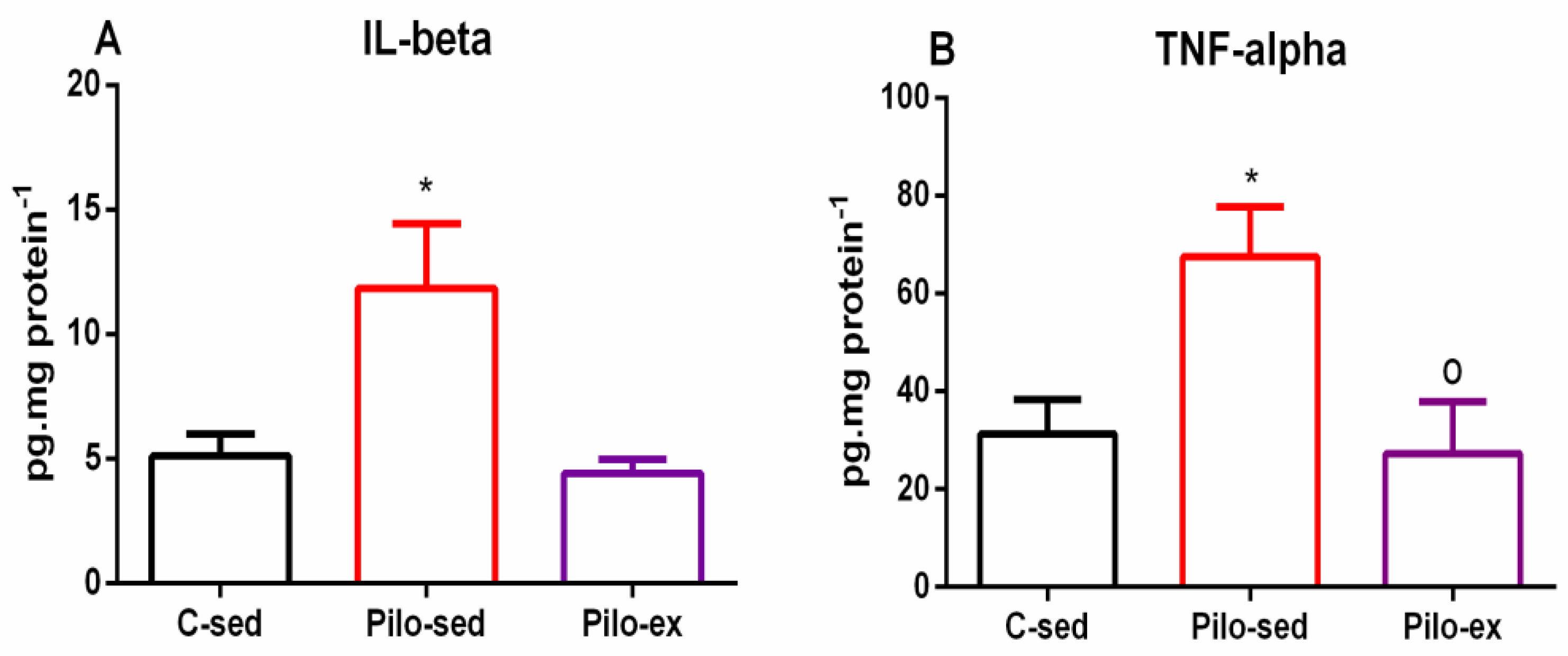
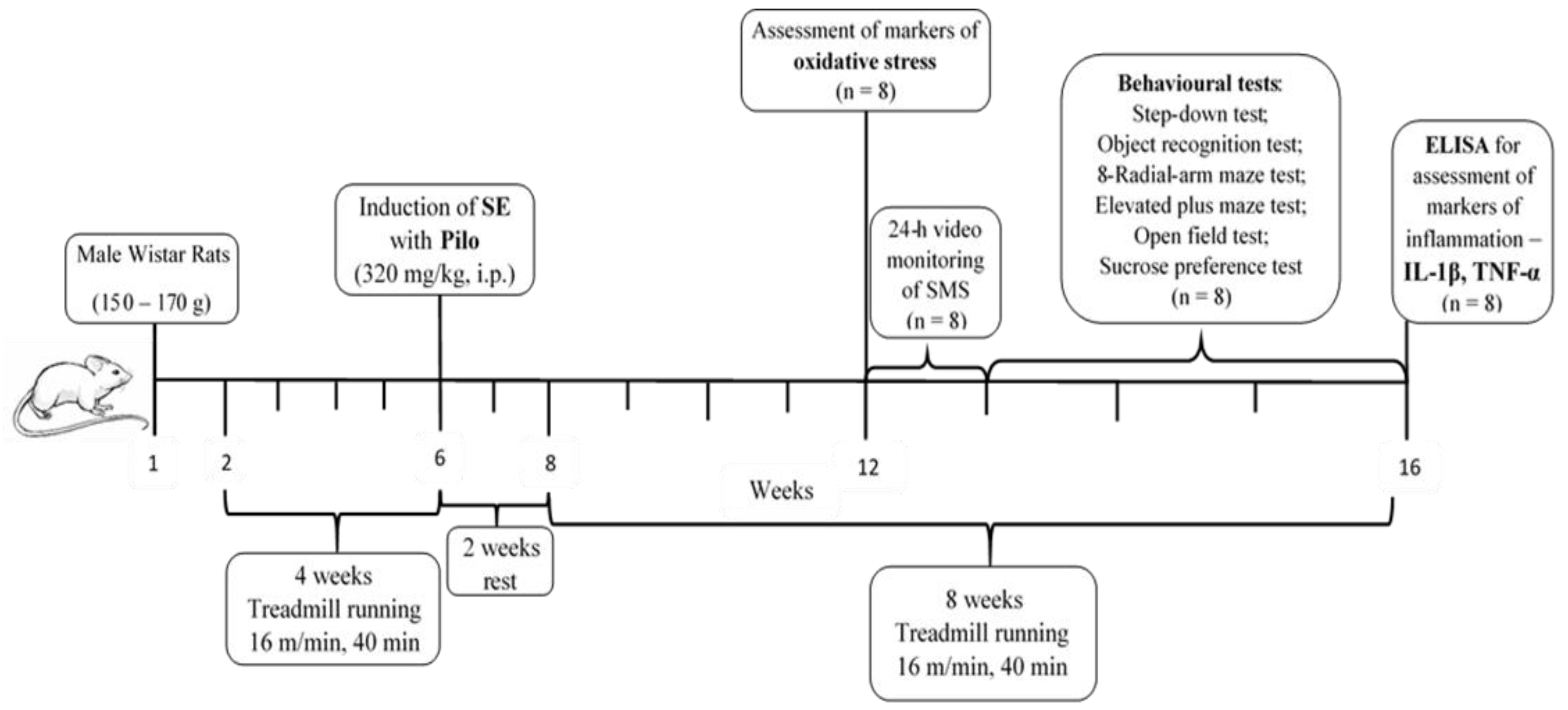
Publisher’s Note: MDPI stays neutral with regard to jurisdictional claims in published maps and institutional affiliations. |
© 2022 by the authors. Licensee MDPI, Basel, Switzerland. This article is an open access article distributed under the terms and conditions of the Creative Commons Attribution (CC BY) license (https://creativecommons.org/licenses/by/4.0/).
Share and Cite
Shishmanova-Doseva, M.; Georgieva, K.; Uzunova, Y.; Ioanidu, L.; Atanasova, M.; Nenchovska, Z.; Tchekalarova, J. Pre- and Post-Endurance Training Mitigates the Rat Pilocarpine-Induced Status Epilepticus and Epileptogenesis-Associated Deleterious Consequences. Int. J. Mol. Sci. 2022, 23, 13188. https://doi.org/10.3390/ijms232113188
Shishmanova-Doseva M, Georgieva K, Uzunova Y, Ioanidu L, Atanasova M, Nenchovska Z, Tchekalarova J. Pre- and Post-Endurance Training Mitigates the Rat Pilocarpine-Induced Status Epilepticus and Epileptogenesis-Associated Deleterious Consequences. International Journal of Molecular Sciences. 2022; 23(21):13188. https://doi.org/10.3390/ijms232113188
Chicago/Turabian StyleShishmanova-Doseva, Michaela, Katerina Georgieva, Yordanka Uzunova, Lyubka Ioanidu, Milena Atanasova, Zlatina Nenchovska, and Jana Tchekalarova. 2022. "Pre- and Post-Endurance Training Mitigates the Rat Pilocarpine-Induced Status Epilepticus and Epileptogenesis-Associated Deleterious Consequences" International Journal of Molecular Sciences 23, no. 21: 13188. https://doi.org/10.3390/ijms232113188
APA StyleShishmanova-Doseva, M., Georgieva, K., Uzunova, Y., Ioanidu, L., Atanasova, M., Nenchovska, Z., & Tchekalarova, J. (2022). Pre- and Post-Endurance Training Mitigates the Rat Pilocarpine-Induced Status Epilepticus and Epileptogenesis-Associated Deleterious Consequences. International Journal of Molecular Sciences, 23(21), 13188. https://doi.org/10.3390/ijms232113188





